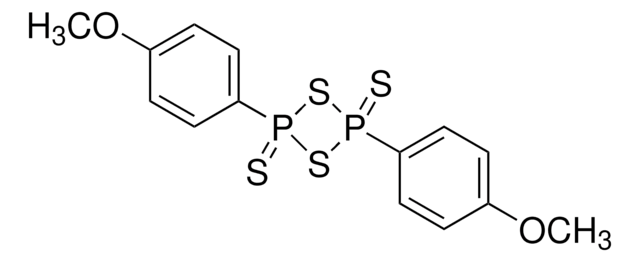718939
Ammoniak -Lösung
0.4 M in THF
About This Item
Empfohlene Produkte
Form
liquid
Konzentration
0.30-0.50 M (by NaOH, titration)
0.4 M in THF
Methode(n)
tissue culture: suitable (plant)
Dichte
0.881 g/mL at 25 °C
Lagertemp.
2-8°C
SMILES String
N
InChI
1S/H3N/h1H3
InChIKey
QGZKDVFQNNGYKY-UHFFFAOYSA-N
Suchen Sie nach ähnlichen Produkten? Aufrufen Leitfaden zum Produktvergleich
Verwandte Kategorien
Anwendung
- Als ein Pheromon in Froschlurchkaulquappen
- Als ein Nährstoff in Erde für Pflanzenernährung
In Studien zum Beitrag von Archaeen und Bakterien zum Ammoniakoxidationspotenzial von Böden
Wechselwirkung von Ammoniak und Xenon mit Imidazolglycerinphosphatsynthase aus Thermotoga maritima
Metabolismus von Ammoniak in Aedes aegypti-Fettkörper- und -Mitteldarmgeweben
Wird von Ammoniak-oxidierenden Bakterien verwendet
Signalwort
Danger
Gefahreneinstufungen
Acute Tox. 4 Oral - Carc. 2 - Eye Irrit. 2 - Flam. Liq. 2 - STOT SE 3
Zielorgane
Central nervous system, Respiratory system
Zusätzliche Gefahrenhinweise
Lagerklassenschlüssel
3 - Flammable liquids
WGK
WGK 1
Flammpunkt (°F)
-7.6 °F
Flammpunkt (°C)
-22 °C
Analysenzertifikate (COA)
Suchen Sie nach Analysenzertifikate (COA), indem Sie die Lot-/Chargennummer des Produkts eingeben. Lot- und Chargennummern sind auf dem Produktetikett hinter den Wörtern ‘Lot’ oder ‘Batch’ (Lot oder Charge) zu finden.
Besitzen Sie dieses Produkt bereits?
In der Dokumentenbibliothek finden Sie die Dokumentation zu den Produkten, die Sie kürzlich erworben haben.
Kunden haben sich ebenfalls angesehen
Unser Team von Wissenschaftlern verfügt über Erfahrung in allen Forschungsbereichen einschließlich Life Science, Materialwissenschaften, chemischer Synthese, Chromatographie, Analytik und vielen mehr..
Setzen Sie sich mit dem technischen Dienst in Verbindung.










